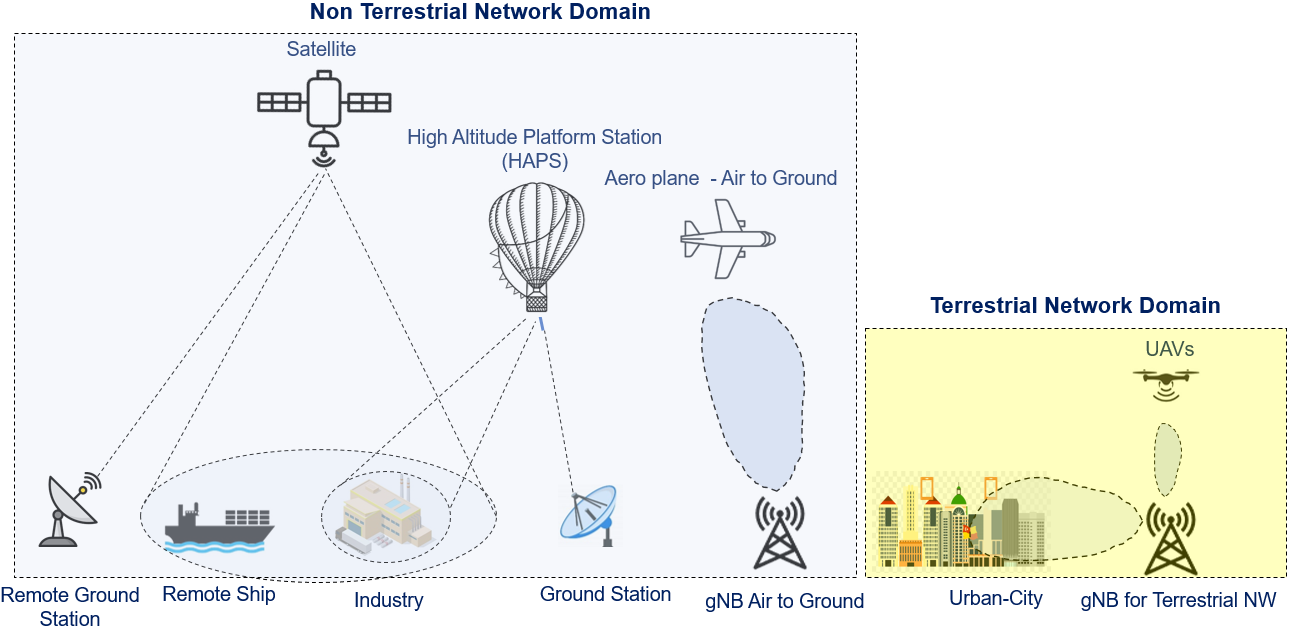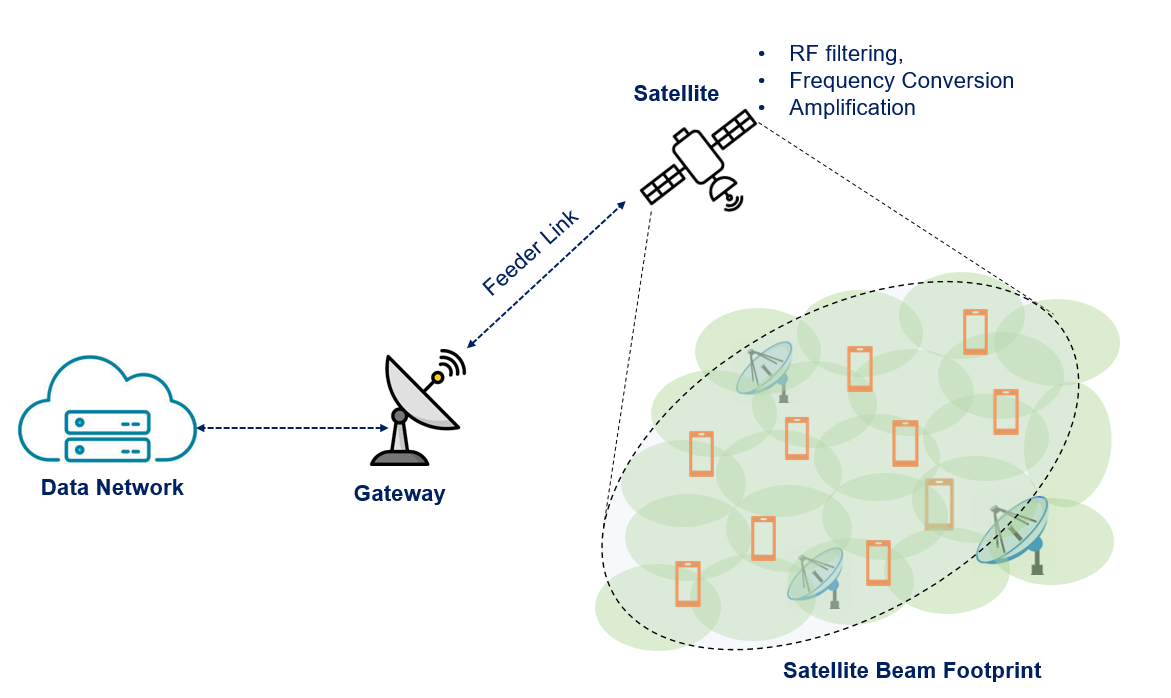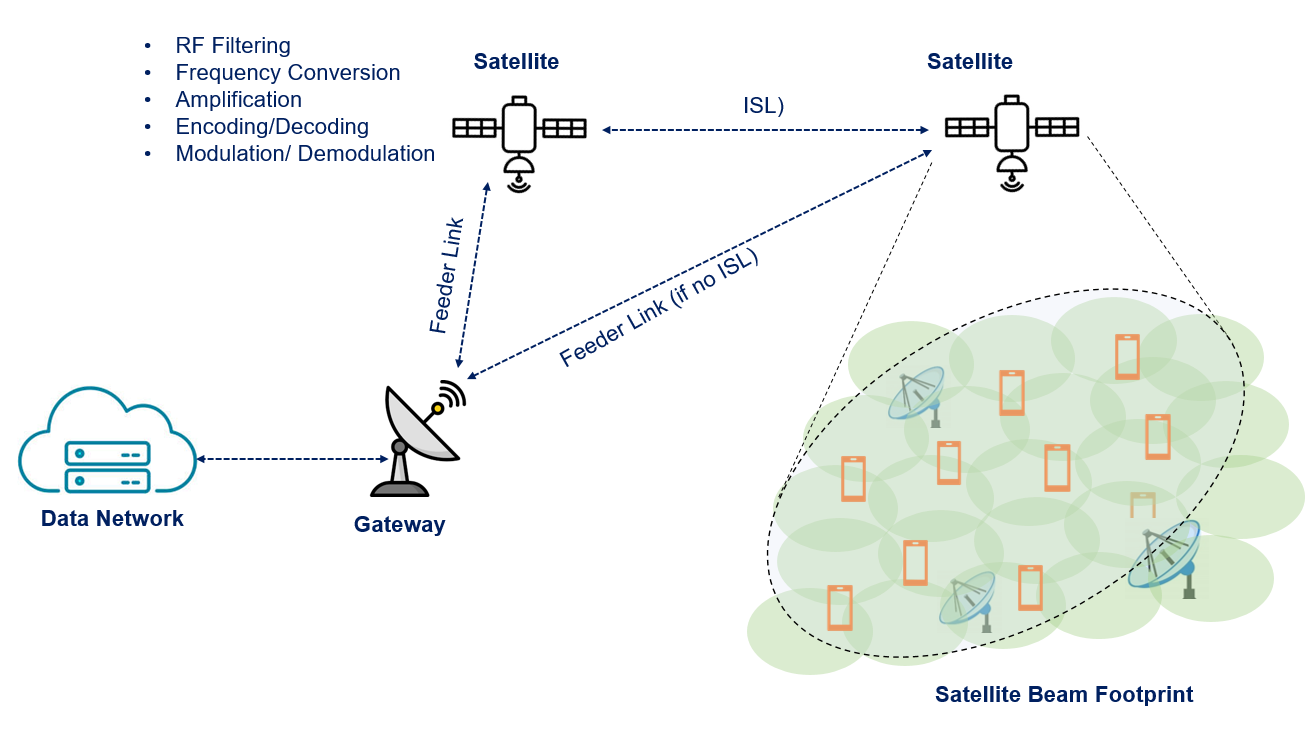5G Satellite Architecture | Transparent and Regenerative Payload
Introduction
The Satellites communication can complement 5G technology and enhance value 5G solving coverage challenges and complex use cases due to Infrastructure limitations. 3GPP 5G standard included NTN satellite segments are part of the 5G ecosystem. In This blog post, we will discuss about the network architecture proposed for 5G Satellite Communication by 3GPP.
3GPP completed the standardization of the 5G NR technology in its Release-15 and evolving further with latest releases 16, 17 etc. 5G NR systems to support non-terrestrial networks (NTNs) has been significant area under exploration in 3GPP work items and studies. NTN has also become an umbrella term for any network that may involve non-terrestrial flying objects which includes satellite communication networks, high altitude platform systems (HAPS), and air-to-ground networks as shown in following picture.

5G Satellite Network Architecture
3GPP TR 38.8211 provided the 5G Satellite Non-Terrestrial Network Architecture and it typically includes following elements.
- Satellite
- A Satellite re-create the NR-Uu radio interface from the feeder link to the service link and vice versa
- A satellite is a transceiver revolving in the orbit, may be implemented with either a transparent or regenerative (with on board processing) payload. The satellite typically creates multiple beams over a area/region to serve bounded by its field of view. The footprints of the beams are typically of elliptical shape. The field of view of a satellite depends on the on-board antenna diagram and minimum elevation angle. A Satellite can be GEO or Non-GEO serving a region.
- A GEO satellite is fed by one or several satellite gateways which are deployed across the satellite targeted coverage e.g. regional, or continent. We can consider the UEs in a cell are served by only one satellite gateway.
- A Non-GEO satellite served successively by one or several sat-gateways at a time. The system ensures service and feeder link continuity between the successive serving satellite gateways with sufficient time duration to proceed with mobility anchoring and handovers.
- Satellite Gateways: One or multi satellite gateways may connects the Non-Terrestrial Network
to a public data network - Feeder link: A feeder link is a radio link between a satellite gateway and the satellite. This link may use NR-u
- Inter-satellite links (ISL): ISL are optional in case of a constellation of satellites. This will require regenerative payloads on board at the satellites. ISL may operate in RF frequency or optical bands
- Service link: A service link is also an radio link. It is between the user equipment (UE) and the Satellites
- UE or Satellite Phone: User Equipment (UE) can be a Satellite Phone, Normal Phone with necessary support within the designated service area.
Satellites Payloads and 3GPP Recommendations
The Satellite Payload refers to the function/purpose of satellite. A communication satellite payload refers to transceivers and Antennas. As per 3GPP TR 38.821, the satellite payload implements frequency conversion and a radio frequency amplifier in both uplink and downlink direction. It corresponds to an analogue RF repeater.
“The electromagnetic wave that are transmitted from Earth surface are converted by a satellite receive antenna into an electric signal which is channel filtered and amplified by low-noise amplifier (LNA). The signal is then frequency converted. A high-power amplifier (HPA) delivers finally the signal to a transmitting antenna generating a reconditioned electromagnetic wave towards the Earth surface where receive station are located”
3GPP with release-16 included studies on following two architectures.
- Transparent Payload
- Regenerative Payload
Transparent Payload
With transparent communication payload RF filtering, frequency conversion and amplifications are performed only at the satellite. Hence, the waveform signal repeated by the payload is unchanged.

Regenerative Payload
With Regenerative Communication payload, RF filtering, frequency conversion and amplification along with demodulation/decoding, switch and/or routing, coding/modulation at the satellite. This is effectively equivalent to having all or some part of gNB functions on board the satellite.

With study and discussions with different workgroups, 3GPP in release 17 decided to standardize the transparent payload option, and not to standardize the regenerative payload option. in Release-17 due to Further with 3GPP Release-18, following three options are considered for the regenerative payload.
- Completed gNB on board Satellite
- gNB-CU on the ground, gNB-DU on board, which face challenges in handling the F1 interface between CU and DU
- Complete gNB on the ground
LLS (Low layer split), RU (Radio Unit) on satellite, which is faced with challenges in the Common Public Radio Interface (CPRI) interface that is not standardized in 3GPP.
References
- 3GPP TR 38.811 : Study on New Radio (NR) to support non-terrestrial networks
- 3GPP TR 38.821 : Solutions for NR to support non-terrestrial networks (NTN)
- 3GPP TR 23.737 – Study on architecture aspects for using satellite access in 5G
- RP-193234 : Solutions for NR to support non-terrestrial networks (NTN)
- TS 22.261 : Service requirements for the 5G system; Stage 1 (Release 18)
Related Posts



